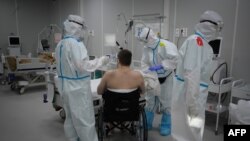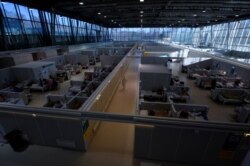The symptoms came on almost laughably textbook.
One morning in late November, my sense of smell suddenly disappeared. Soon my muscles ached and I developed a headache that resembled a spike dancing on my head.
Then there was the hacking cough, the nausea, the sweats, the chills.
It took a few days before tests confirmed what was already obvious to me: I had contracted the coronavirus.
After unsuccessfully convalescing at home for the better part of a week, city paramedics came to my Moscow apartment and insisted I was overdue for a CT scan of my lungs.
The ambulance brought me to a nearby clinic retrofitted for assessing coronavirus patients. Medics in now standard PPE “spacesuits” manned a cavernous reception area full of worn-out benches with scattered X’s taped to them to encourage social distancing.
Everyone looked sad. I probably did too.
Whether you think the coronavirus is dangerous or not — there’s a deep-seated belief in everyone, I suspect, that you can outrun it. Or that it can’t hurt you. Or that you’ve been careful enough.
But here we all were. On the benches. Our turn had come.
A CT scan showed “up to” 49% damage to my lungs — a number that, combined with a preexisting condition, was enough to convince my examiner, Olga, that I should be under more steady observation in a hospital.
Noticing that I was an American, Olga mentioned she had worked in a COVID ward in New York during the first wave of the epidemic in the U.S. last spring. She had been granted an emergency medical license allowing her to treat Americans with the coronavirus.
“Thanks for doing that,” I said. I meant it. Like many, I had followed the news as New York was overtaken by the virus last spring — killing thousands.
“You’re welcome,” she said.
She also confessed she’d never been paid so much in her life.
I could understand why.
Health care worker salaries are shamefully low by even Russian standards — a fact that prompted President Vladimir Putin to rightly offer danger pay bonuses to frontline staff amid the pandemic.
Let me be clear: The vast majority of Russian health care workers are dedicated professionals. But why else should they risk their lives for next to nothing? And those of their families?
Why would anyone?
Under the new Putin rules, doctors in the “red zone” collect just over $1,000 a month, with pay scaled down for nurses, EMTs, and other personnel.
In Russia’s current economic climate, that has made caring for COVID patients a dangerous but fairly lucrative profession — at least for those who’ve managed to collect. And survive.
Complaints about money gone missing abounded in the early days of the pandemic. Meanwhile, an informal In Memoriam list of health care workers felled by the virus sits at 1,000 and counting.
The kitchen debates
I was transferred to a makeshift hospital in Moscow’s Sokolniki Park — a location that struck me as comically appropriate given its history with the U.S.
The park was host to the so-called American National Exhibition in 1959 — a moment made famous by the impromptu so-called ‘kitchen debate’ between Soviet Premier Nikita Khrushchev and then Vice President Richard Nixon over which society was more advanced: the United States or the USSR.
Today, that competition is playing out in the realm of vaccines. Russia was quick — too quick, international health experts ague — to claim it had won the race to develop a COVID vaccine with its “Sputnik V.”
The U.S. has since green-lighted the Pfizer and Moderna vaccines. Russia says it has alternatives nearly ready for approval. Moscow and Washington have been dueling with efficacy rates for months.
Given the state of U.S.-Russian relations, it feels like a new front in the new Cold War. Only this one fought with needles.
Pop-up hospitals
To some, I imagine, the idea of a stay in a Russian hospital conjures up images of horror.
Frankly, my own impressions haven’t been great, either.
Russian friends have come out of city clinics even before the epidemic with little good to say about the experience.
Even as a foreigner I’d been in Moscow hospitals that were dilapidated and filthy.
Only that wasn’t the case here.
My bed was in a large exhibition pavilion hangar that authorities converted into a makeshift COVID ward as the pandemic surged in Moscow. It was a massive building organized open office-style, with waist-high dividers between beds, with separate sections for men and women.
But each patient cubby was equipped with an oxygen feed and a small dresser. There was even a flight attendant-style buzzer should you need anything. (It seemed to work the one time I did).
There was WIFI — along with rules to not photograph patients or staff, which I respected. The common areas and toilets were clean.
The food? Not great but decent enough. And there was plenty.
Another amenity: a lounge area with soft-cushioned couches and a TV. It usually sat empty.
While I’m on comforts: I’d been admitted to the hospital without warning — and, accordingly, hadn’t had time to bring any personal items. When I told them so, a nurse gave me a dock kit with toothpaste and other essentials to tide me over until Russian friends could deliver the rest at a drop off point outside the park.
Less pleasant: patients were told not to wear masks, a concept I found hard to understand as I watched and listened to those around me.
And that is what we all did.
The clinic wasn’t a chatty place. I got to know my neighbors mainly through observing.
The patient opposite me listened to endless sitcom sketches and the news from the recent cease-fire in Nagorno-Karabakh on his phone — without headphones.
Given that he seemed to have relatively minor symptoms, he was the first of ‘us’ to be released. (I swore if we ever met again, I’d gift him a set of earbuds.)
Kitty corner: a pudgy gentleman who wheezed like a carburetor in need of deep repair. I felt badly for him. But when he started coughing, I felt badly for me, too. I quickly turned in the other direction and slipped on my oxygen mask.
There was also an older couple in their 80s — a husband and wife, if I was to guess — whom I’d see meeting daily in the corridor to take a slow walk, holding hands.
Treatment-bound
The ward was staffed by medical students in their early 20’s — their youth underscored by how they’d written their names in abbreviated form on their uniforms. Names like ‘Polya’ (Polina) ‘Sasha’ (Alexander) and ‘Dima’ (Dmitry).
The staff I met all seemed to be from southern Russia — cities like Makhachkala, Krasnodar, and Rostov — who said they’d volunteered to work in Moscow for the experience and higher pay.
But what they lacked in years they made up in enthusiasm.
“Good morrrrrning!” chimed ‘Vova’ (Vladimir), who greeted me in English followed by an anticoagulant shot to my gut every morning at 7 am.
“Damn I wish I could speak English,” he added switching back into Russian. “Moscow has all these foreigners and I can’t say a word to them.”
He asked to look through my passport. “I would love to go sometime,” he said.
I hope he will. After all, he’s only 21.
Doctor Anatoly’s therapy
The senior doctor in our ward was “Doctor Anatoly” — whose few wrinkles I could see through his goggles I found oddly comforting.
He made his rounds among the patients every morning in a whirl — his impending arrival announced by the rapid sounds emanating nearby.
‘Thwack! Thwack! Thwack!’
‘Thump! Thump! Thump!
Instructing patients to lie on their stomachs — a common practice —- Doctor Anatoly would proceed to pound them with blows to the back in an effort to dislodge the virus as patients heaved and sucked for oxygen.
And it seemed to work. At least with me.
I hacked and coughed and slept and read. Read and slept and coughed and hacked. It was a routine that after a week had me feeling…if not good, then certainly not as bad as when I’d come in.
No doubt administered medication — a combination of antivirals (triazavirin), antibiotics (amoxicillin) and three doses of the rheumatoid arthritis drug baricitinib (until they ran out) helped, too.
On Day 6, I was invited to take part in a group exercise class. I took it as acknowledgment of my progress.
We gathered near the pavilion windows and proceeded to mimic our doctor’s motions — bad ballerinas all. Simple movements taxed our lungs. We fell over given easy balancing exercises.
But I could tell: I was clearly feeling better.
“You should be grateful,” Doctor Anatoly said quietly when he came to check on me the next day. “Look around you.”
I had. I’d taken walks around the pavilion enough to see the ICU ward of patients on ventilators.
It was time for me to go home,
Besides, Russia has 20,000-plus new cases daily — with a nearly a quarter of them in Moscow. Others would surely need my bed.
Road to recovery
Over the past month I’ve recuperated at home and thought about my experience.
Of course, I realize the care I was getting isn’t typical for everyone. But it was typical for Moscow. I’ve seen pictures of similar makeshift COVID wards from around the city that looked identical.
The capital is the epicenter of the virus and demands resources. Yet the pandemic has again highlighted how the city benefits from lavish funding the rest of the country lacks.
The evidence is everywhere — streets and sidewalks immediately shoveled when it snows, in holiday decorations to mark the New Year, and in seemingly having enough beds to treat the sick amid a pandemic.
Even one for me.
If that sounds overly rosy, let me add: I’ve done enough reporting on the Russian fight against the coronavirus to know the picture is far from ideal.
There’s more than enough evidence to suggest the infection numbers — and deaths — are worse than official statistics would suggest.
I’ve also spoken to medical professionals in the regions fighting for the same heightened pay doled out in Moscow. The situation has improved but hardly resolved.
And there were other negative moments.
My experience with Russia’s ‘social monitoring' system — rightfully launched to prevent those with the virus from leaving their homes and infecting others — raises legitimate concerns of abuse by the state security apparatus.
But I’ve had health crises before and one thing I know is they provoke is a terrible sense of sentimentality and gratitude. So bear with me.
For those who cared for me under difficult circumstances — thank you. Stay healthy and good luck with your lives and careers.
For those who were ill with me — I hope you’ve since recovered and are home with your families and loved ones.
For friends who gave (and the many others who offered) help — my eternal gratitude. You’re family to me. (Whether you want to be is another issue…).
And for those who are nervously waiting for a vaccine — Sputnik? Pfizer? Moderna? AstraZenica? Who cares?
Let’s hope they all work.
Wherever you are.






